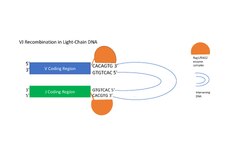Biology:Recombination signal sequences
Recombination signal sequences are conserved sequences of noncoding DNA that are recognized by the RAG1/RAG2 enzyme complex during V(D)J recombination in immature B cells and T cells.[1] Recombination signal sequences guide the enzyme complex to the V, D, and J gene segments that will undergo recombination during the formation of the heavy and light-chain variable regions in T-cell receptors and immunoglobulin molecules.[1]
Structure
RSSs are made up of highly conserved heptamer sequences (7 base pairs), spacer sequences, and conserved nonamer sequences (9 base pairs) that are adjacent to the V, D and J sequences in the heavy-chain region of DNA and the V and J sequences in the light-chain DNA region.[1][2] Spacer sequences are located between heptamer and nonamer sequences and exhibit base pair variety but are always either 12 base pairs or 23 base pairs long.[3] Heptamer sequences are usually CACAGTG and nonamers are usually ACAAAAACC. The nucleotides in bold are more highly conserved.[3] The RAG1/RAG2 enzyme complex follows the 12-23 rule when joining V, D, and J segments, pairing 12-bp spacer RSSs to 23-bp spacer RSSs.[1][2] This prevents two different genes coding for the same region from recombining (ex. V-V recombination).[1] RSSs are located between V, D, and J segments of the germ-line DNA of maturing B and T lymphocytes and are permanently spliced out of the final Ig mRNA product after V(D)J recombination is complete.[1]
Function
The RAG1/RAG2 enzyme complex recognizes the heptamer sequences flanking the V and J coding regions and nicks their 5' end, releasing the intervening DNA between the V and J coding regions.[1] In the heavy-chain coding region of DNA, the RAG1/RAG2 enzyme complex recognizes the RSSs flanking the D and J segments and brings them together, forming a loop containing intervening DNA.[1][4] The RAG1/RAG2 complex then introduces a nick at the 5' end of the RSS heptamers adjacent to the coding regions on both the D and J segments, permanently removing the loop of intervening DNA and creating a double-stranded break that is repaired by VDJ recombinase enzymes.[1][4] This process is repeated for the joining of V to DJ.[1] In light-chain rearrangement, only V and J segments are brought together.[1]
Related Diseases & Disorders
cRSS
Cryptic RSSs are gene sequences that resemble authentic RSSs and are occasionally mistaken for them by the RAG1/RAG2 enzyme complex.[3] Recombining an RSS with a cRSS can lead to chromosome translocations, which can lead to cancer.[3]
Omenn's Syndrome
Some infants born with autosomal recessive SCIDS lack a functional copies of the genes that code for the RAG1/RAG2 enzyme complex because of missense mutations.[5][6] These infants will produce a non-functional RAG1/RAG2 enzyme complex that cannot recognize RSSs and therefore cannot initiate V(D)J recombination effectively.[5][6] This disorder is characterized by a lack of functioning B and T cells.[1][5]
References
- ↑ Jump up to: 1.00 1.01 1.02 1.03 1.04 1.05 1.06 1.07 1.08 1.09 1.10 1.11 Owen, Judith A.; Punt, Jenni; Stranford, Sharon A. (2013). Kuby Immunology. New York: W.H. Freeman and Company. pp. 233–235.
- ↑ Jump up to: 2.0 2.1 Schatz, David G.; Oettinger, Marjorie A.; Schlissel, Mark S. (1992). "V(D)J Recombination: Molecular Biology and Regulation". Annual Review of Immunology 10: 359–383. doi:10.1146/annurev.immunol.10.1.359. PMID 1590991.
- ↑ Jump up to: 3.0 3.1 3.2 3.3 Roth, David B. (2014). "V(D)J Recombination: Mechanism, Errors, and Fidelity". Microbiology Spectrum 2 (6): 1–11. doi:10.1128/microbiolspec.MDNA3-0041-2014. ISBN 9781555819200. PMID 26104458.
- ↑ Jump up to: 4.0 4.1 Rodgers, Karla (2017). "Riches in RAGs: Revealing the V(D)J Recombinase Through High-Resolution Structures". Trends in Biochemical Sciences 42 (1): 72–84. doi:10.1016/j.tibs.2016.10.003. PMID 27825771.
- ↑ Jump up to: 5.0 5.1 5.2 Buckley, Rebecca H. (2004). "Molecular Defects in Human Severe Combined Immunodeficiency And Approaches to Immune Reconstitution". Annual Review of Immunology 22: 625–655. doi:10.1146/annurev.immunol.22.012703.104614. PMID 15032591.
- ↑ Jump up to: 6.0 6.1 Elnour, Ibtisam B; Ahmed, Shakeel; Halim, Kamel; Nirmala, V (2007). "Omenn's Syndrome: A rare primary immunodeficiency disorder". Sultan Qaboos University Medical Journal 7 (2): 1–6. PMID 21748095.
 |


